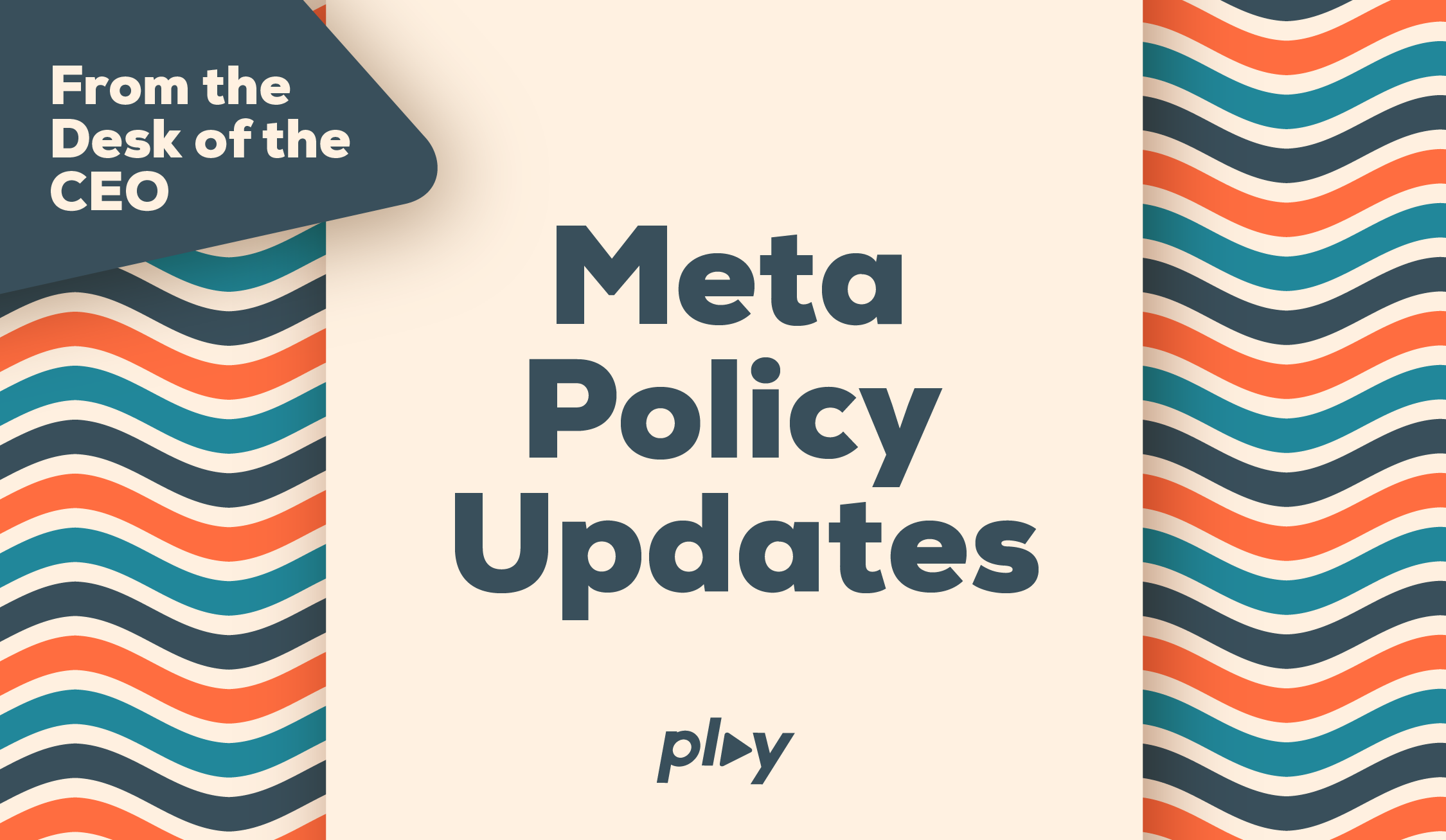PLAY Meta Policy Updates

If you use any version of advertising or digital marketing, it’s imperative to stay informed about the platforms that serve as our primary conduits to audiences. Meta—home to Facebook, Instagram, and Threads—has introduced significant policy changes for 2025, altering the way brands engage with their audiences. This blog dives deep into these updates, providing data-backed insights and actionable strategies to navigate the shifts effectively.
1. From Fact-Checking to Community Notes
What Changed: Meta has replaced its third-party fact-checking program in the U.S. with a user-driven “Community Notes” system. This approach entrusts users to flag misinformation and provide context.
Why It Matters: Community Notes shifts content credibility from independent organizations to a collective responsibility. As of Q4 2024, Meta reported 3.8 billion monthly active users across its platforms—a vast audience now partially tasked with ensuring content reliability.
Impact on Marketers:
- Trust Metrics: A study by Edelman’s Trust Barometer found that 58% of users are skeptical of information on social media. Marketers must now double down on ensuring the factual accuracy of their content to build brand trust.
- Engagement Strategy: With over 10,000 flagged posts daily under the pilot program, brands have an opportunity to engage proactively, addressing concerns and fostering transparency.
Example Strategy: Launch behind-the-scenes content showcasing product development or fact-check your own campaigns publicly to enhance credibility.
2. Relaxation of Speech Policies
What Changed: Meta’s new guidelines permit previously restricted statements, raising concerns about potential increases in harmful content.
The Data:
- In 2024, Meta’s quarterly transparency report revealed a 37% reduction in content flagged for hate speech, coinciding with the policy shift.
- Brands spent an estimated $118 billion globally on digital ads in 2024; ad placements beside controversial content could jeopardize ROI and brand perception.
Impact on Marketers:
- Ad Placement Risks: 64% of consumers said they would boycott brands whose ads appear next to offensive content (HubSpot, 2024).
- Community Dynamics: A 2023 Pew Research study found that 45% of users believe platforms’ moderation policies directly impact their perception of brand safety.
Proactive Measure: Opt for tools like Meta’s Inventory Filters to avoid sensitive content categories. Utilize third-party brand safety tools for added assurance.
3. Restrictions on Health and Wellness Advertising
What Changed: Health and wellness advertisers face new limitations on event tracking, such as “Add to Cart” or “Purchase,” for ad optimization.
By the Numbers:
- The global wellness market, valued at $4.4 trillion in 2023, is a significant driver of digital ad spend.
- A/B tests conducted by Digital Position showed a 22% drop in ROAS when wellness brands shifted from conversion-focused objectives to engagement metrics.
Impact on Marketers:
- Performance Tracking: Conversion events like “Landing Page Views” or “Engagement” require alternative KPIs to measure success.
- Budget Reallocation: Companies may need to increase their investment in creative development by 15-20% to compensate for less precise targeting (Statista, 2024).
Example Strategy: Create video content that highlights testimonials or product benefits, prompting clicks to dedicated landing pages for deeper engagement.
Visual Insights: Navigating Policy Changes with Precision
Scenario: A wellness brand promoting a new supplement line on Instagram.
Pre-2025 Strategy:
- Ad Objective: Conversions (e.g., “Purchase”).
- Targeting: Interest-based audiences.
- Measurement: ROAS through Meta’s event tracking.
Post-2025 Strategy:
- Ad Objective: Engagement (e.g., “Video Views”) or Traffic.
- Targeting: Retargeting via website traffic and lookalike audiences.
- Measurement: Engagement rates and landing page visits.
Execution: Use dynamic video ads featuring customer stories, backed by real-world stats (e.g., “95% of our users report improved energy levels within two weeks”). End with a compelling CTA: “Learn how our product transforms lives.”
What This Means for Marketers
Meta’s policy updates aren’t just tweaks—they’re tectonic shifts in how we navigate digital marketing. From ensuring brand safety in a more lenient content moderation landscape to adapting to new metrics in restricted categories, marketers must stay agile.
Key Takeaways:
- Prioritize Transparency: Engage audiences with clear, accurate, and verifiable content.
- Optimize Creatively: Invest in storytelling and visuals to drive engagement.
- Monitor and Adapt: Leverage analytics to track performance and pivot strategies as needed.
The future of digital marketing is nuanced, complex, and brimming with opportunity for those willing to innovate. As we adapt to these changes, one principle remains clear: Agility and integrity are the cornerstones of success in the Meta-driven era of 2025.
